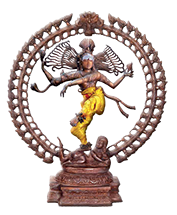MeikaNdaar
by
Natesan Muthukumaraswamy
Sivak kudil, Kovaiputhur
Today we celebrate the Gurupuja of Sri MeikaNda sivachariyar, the preceptor of Suddahvitha vaithika saiva siddhantham. He was born in 13th century , much later than Sankara, Ramanuja and He felt the interpretation of ‘adhvaitham’ by these three Acharyas and the principles of Abedha, BhedhAbedha and Bheda were inadequate. He has the credit of finding a solution to the Abheda, Bheda, and Bhedabheda polemics.
His interpretation of addhvaitham encompasses all the three principles namely Bedha , Abedha and Bedhabeddha. Instead of ‘Abheda’ he uses the word “Oneness’ the union of the soul and God – onRAthal ஒன்றாதல். Soul cannot survive separate from God. Instead of Bheda the term ‘vERaathl வேறாதல்’ separate is used. Though eyes have the capacity to see, it cannot see a thing unless sun- light mingles with eyesight. Sun is separate from eye. So also, God is separate from soul, but sivasakthi coalesce with the eye to empower it to see. In the place of Bhedabheda, the term ‘ toghether’ – udanAthal – உடனாதல்” is used. When the eyes see an object , the ‘Athma cit sakthi’ enlightens the eye the thing it sees, staying together with it.
Adhvaitham’ according to Saiva siddhantam is the relation of God with the soul. It rejects ‘adhvaita’ in the sense of Ekam or one. This relation is neither abedha like gold and ornament, nor bedha like darkness and light, and also not bedhabedha like word and meaning . Though God and soul are distinct entities, their relationship is inseparable. But the God is not the soul and the soul does not become God. This relation is called ‘privarum ahthuvitham – பிறிவரும் அத்துவிதம்). This relation between God and soul subsists not only in the liberated state – ‘mutta nilai’ but also in the ‘petta nilai’ (bond state). Soul exists in God; it has no existence without God just like the vowel ‘A’ (அகர உயிர்) that pervades all other letters
The word used in ThirumuRai to mean ‘adduvitham’ is ‘udanaathal’ (உடனாதல்) which means ‘togetherness’. Whether it is bound state or free state, God is together with the soul. In bound state ‘mala’ the impurity veils the togetherness; In the free state there is no mala to veil this togetherness. In the bound state soul is with mala; and therefore, its intellect is obliterated. In the free- state the soul is with Siva. Who is personified as Bliss and happiness, which the soul enjoys. This dual nature of the soul is called the ‘virtue of assimilation” –sArnthathan vaNNamaathal – சார்ந்ததன் வண்ணமாதல்)
Siva operates his function of liberating the soul from its bondage by dwelling in the soul . Saiva samaya Acharyar Manikkavasaka swamigal says,” O my true One You abode in my soul as Om for my redemption!” .”He envelops all things and fosters them!” (உய்யவென் னுள்ளத்துள் ஓங்கார மாய் நின்ற மெய்யா, மருவி எப்பொருளும் வளர்ப்போன் காண்க) In the free- state , there is no mala to veil the togetherness. In free- state the soul does not become God, but enjoys the togetherness. This the uniqueness of the MeikandAr school of Saiva Siddhantam.
Unlike Sankara and others, MeikaNdAr never relied upon ‘Prasthana-thraya’ – the triple scriptures of Upanishats, Bagavat Gita and Brahma Sutras – to construct his philosophy. On the contrary, he relied upon vedas and Agamas and very much solely on the traditional thought of the Tamil. The utterances of Nayanmaar are who sang their divine experiences in the Hymns inspired by Siva, the Almighty. Saiva siddhantham in Tamil Nadu is justified to assert as ‘thirumuRai saivam’. ThirunuRai is also ‘vaithikam’ as it elucidates vedic principles. Original thinking of MeykaNdaar is suffused with vedic agamic thoughts. This is vouched by the terms he had put in service in ‘Sivanjaana Botham’ . Traditionally, it is believed that ‘Sivanjaana Botham’ is translation of 12 sutras in Rowrava Agama. But this is disputed. However, he had used many Sanskrit words in his 12 aphorisms, such as, 1. Thithi 2 antham, 3. Athi. 4. Maaya. 5. Iyanthiram 6. Thanu. 7. Anmaa. 8.anthakaraNam. 9. Sakajam. 10. Avathai. 11.kaantham. 12. Pasaasam 13. Sivasath 14.sUnyam 15. Sath. 16. Asath. 17, annyam and many more,
The term ‘advaidha’ is used in vedas, according to Saiva Siddhanta, in the sense of Union ‘ (sambandham , relation) and not unit (numerical identity). The relation between two entities could be either ‘aikya’ is union and not ‘athvaidham’; it i like water with water. The other is of two entities joining together in union with difference. Saiva Siddhanta cites a grammatical instance thAL – தாள் and thalai – தலை. Thhal (தாள்) is Sivam, thalai is soul. When the words thaal and are compounded according to Tamil grammar, this conjunction forms a word thaadalai – தாடலை . ள்+த் resuls in ட். ட் ‘d’ is neither one or two; neither’ ள் orத் . This is the kind of relation between Sivam and the soul in the advaitha relation. In this relation no bedha, abedha or bedhabedha relation between God and soul The ‘thaadalai’ relation is otherwise called ‘anya nasthi’ – abolition of alienness. It is said this interpretation of advaitham settles and harmonises bedha, abedha, bedhaabedha conflict in the Indian philosophy
I do not mind whether Sivanjaana Botham is Tamil original or translated from Sanskrit; my aim is to study and be benefited.


